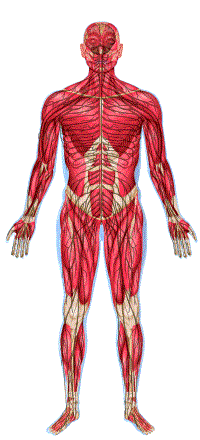Muscles in the body are of three different types: the muscle of the skeleton (
voluntary muscle), that moves the limbs, is called striated, because it looks striped under a microscope. It consists of fibres containing many contractile units called myofibrils which have alternating light and dark bands, representing the two proteins actin and myosin which pull over each other when the muscle contracts. Each muscle fibre has its own end plate, where the nerve joins, and contains many nuclei. When the nerve sends a signal, the chemical acetylcholine is released at the end plate and binds onto its receptor (like a key in a lock). This causes a channel to open in the membrane of the muscle and there’s a flow of sodium and potassium ions across it - the muscle contracts. The acetylcholine is destroyed by an enzyme (called acetyl cholinesterase), the ions are pumped back and the muscle relaxes. The way in which muscles of the skeletal system work together depends on what we're asking them to do - when we're trying to bend a joint the muscles that we use to straighten it need to relax, or they will oppose, or antagonise the action. If we want to steady the joint they need to contract together (called synergy). Some actions need a gradual relaxation - for example when a lowering a child to the ground. The control of these actions depends upon the integration of the sensory input from the stretch receptors in the muscles and tendons, and the position receptors in the joints, together with the conscious knowledge of what we want to do which allows us to control movement. There are, however, movements which we cannot control called reflexes: tapping the tendon under the kneecap makes your knee jerk, and you can't stop it; something in your eye will make you blink. Reflexes are called reflexes because they happen without passing through the higher centres of the brain. Certain diseases affect these reflexes.


 - Tell me more about the Muscles and Nerves.
- Tell me more about the Muscles and Nerves.